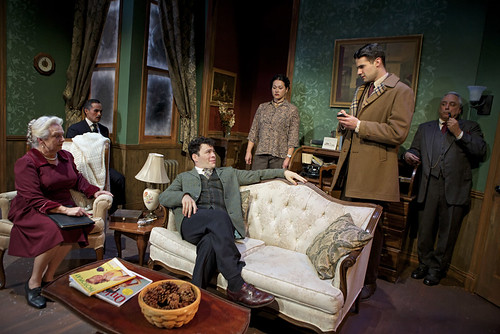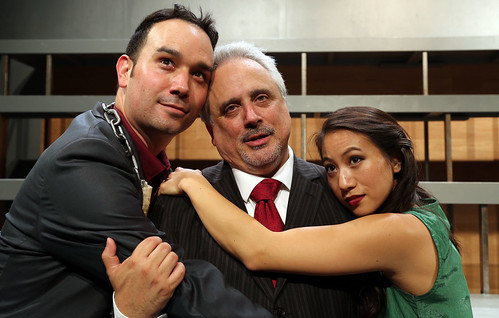
Megan Trout is Mollie Ralston and Mick Mize is Giles Ralston in Shotgun Players’ production of The Mousetrap by Agatha Christie. Below: The cast of suspects includes (from left) Trish Mulholland as Mrs. Boyle, Alex Rodriguez as Mr. Paravincini, Nick Medina as Christopher Wren, Karen Offereins as Miss Casewell, Adam Magill as Detective Sergeant Trotter and David Sinaiko as Major Metcalf. Photos by Pak Han
Why is a good old murder mystery so damn satisfying and enjoyable? There’s something about mystery presented, red herrings chased, clues gathered and a culprit revealed that rarely ceases to please on some level, and there’s no better master of this from than Agatha Christie. I went through a Christie phase in middle and high school and still return to her books often as a treat.
Even though Christie’s most famous, play The Mousetrap, is the longest-running show of any kind in the world (the London production is in its 64th year, with more than 25,000 performances logged) and is performed by school and community theaters on a regular basis, I had never seen it. Nor had I heard one peep about whodunnit, which is really something for such a popular play
So when Berkeley’s Shotgun Players announced The Mousetrap as part of its season of women playwrights, I was thrilled at the prospect of at last seeing the play performed by an exciting, enterprising company.
I wasn’t disappointed – in Shotgun or Christie. They’re both at their reliable best.
From the British winter coziness of Mark Huesek’s guest house set and lights to the stitch-perfect 1950s costumes by Valera Coble, everything looks just right. Director Patrick Dooley’s affection for the play comes through in his straightforward approach to the play (there’s no sense of irony, nor is there the tang of overripe melodrama). There are wonderful flourishes of humor throughout the plays’ nearly 2 1/2 hours, but when the tension needs to intensify in Act 2, it does.
Dooley’s sturdy cast features wonderful turns by longtime company member Trish Mulholland as Mrs. Boyle, a gruff British matron and Megan Trout (also a company member) as Mollie Ralson, the nervous newlywed proprietor of a newly opened guest house. There’s a dance with caricature in both performances, but these wonderful actors keep the inner lives of the characters bubbling up in funny and sometimes surprising ways.
There’s abundant humor in Alex Rodriguez’s performance as the unexpected guest, Mr. Paravincini, a “foreigner” of unknown origin and Nick Medina’s jittery Christopher Wren. Wren has a brief flirtation (most likely not in Christie’s script) with Adam Magill’s Detective Sergeant Trotter that emerges as one of the evening’s funniest bits.
Christie gives us reason to suspect everyone on stage, which makes the ending all the more satisfying as it twists its way to resolution. But the real fun is watching everyone suspect everyone else. Especially paranoid is Mick Mize’s Giles, husband of Mollie, who was not where he said he would be the day a certain murder was committed. But then again, Mollie wasn’t where she was supposed to be either. The sense that this young marriage is going to endures dwindles as the play progresses.
Rounding out the list of suspects is David Sinaiko as the pipe-smoking Major Metcalf, a seemingly reasonable older gentleman but suspiciously not quite who he seems to be, and Karen Offereins as the enigmatic Miss Casewell, who has only just returned to England after a life abroad.
One murder happens before the play begins and one during, and I must say I was mightily disappointed to see the victim disappear from the cast. I’d like Christie to have done a Clue-like version with variations on who the murderer turns out to be. Based on this production, my favorite murderer would be the victim.
But Christie has a very specific ending for this Mousetrap, and it’s juicy and satisfying (though at intermission, the people in my row informally polled one another about who they thought had done it, and my theory proved to be true, thus demonstrating that my internal Miss Marple is alive and well). During the curtain call, the cast keeps the tradition alive by asking the audience to keep mum on the subject of the killer. But really, who’d want to spoil the fun?
And fun is what this production has to offer. In abundance.
FOR MORE INFORMATION
Shotgun Players’ production of The Mousetrap by Agatha Christie continues through Jan. 24 at the Ashby Stage, 1901 Ashby Ave., Berkeley. Tickets are $20-$40. Call 510-841-6500 or visit www.shotgunplayers.org.



